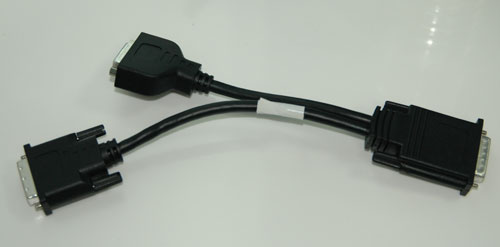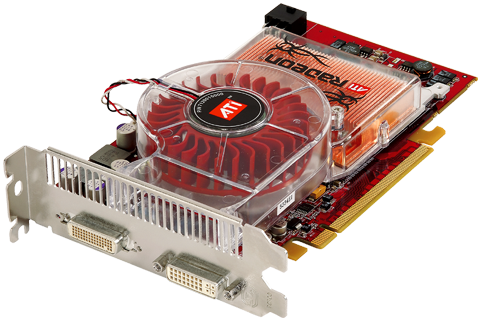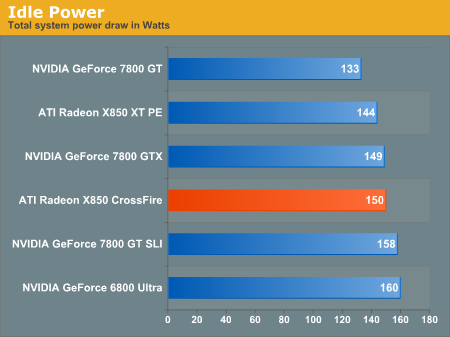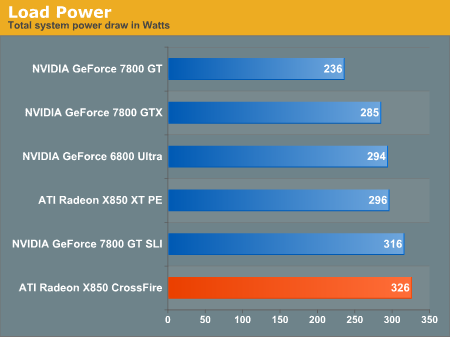ATI's X8xx CrossFire Graphics Arrive
by Derek Wilson on September 26, 2005 1:00 PM EST- Posted in
- GPUs
Hardware and Power
The components that go into a CrossFire system consist of the CrossFire master card, a slave card, a CrossFire dongle, and a motherboard with more than 1 PCI Express x16 slot. Here's the run down of our test system:AMD Athlon 64 FX-55
ATI Radeon Xpress 200 CrossFire motherboard
1GB DDR400 2:2:2:8 RAM
120GB Seagate 7200.7 HD
OCZ Powerstream 600W PSU
The CrossFire master card is basically an X850 XT with the addition of a Xilinx FPGA (for the compositing engine) and a TMDS receiver for taking input from the slave card. Instead of 2 DVI-D ports, the CrossFire master card makes use of a high speed DMS port. This connects to one port of the CrossFire dongle and takes the slave card input as well as providing the output to the monitor.

Other than that, the CrossFire card looks just like any other X850 XT out there.

The CrossFire design is fundamentally different than NVIDIA's SLI. CrossFire uses an external compositing engine while NVIDIA's is built into the GPU. ATI handles communication via TMDS output from the slave card's framebuffer, while NVIDIA built a chip to chip communications protocol for multi-GPU operation. Both vendors offer extended antialiasing modes, but ATI offers an additional rendering mode called SuperTiling which cuts each scene up into a checkerboard pattern for rendering.
On both solutions, Alternate Frame Rendering (AFR) is the fastest mode, as this is the only mode that also accelerates geometry processing. In order to learn more about the details of how CrossFire works, please check out our previous article on the subject.
As for the stress all this hardware puts on a system when it's in action, here's a comparisons of idle and load power (under Splinter Cell: Chaos Theory). Power is measured at the wall before the PSU.


While the idle power draw is slightly lower than 7800 GT SLI, the load power is the highest of any of the measured setups. 7800 GTX SLI would be higher still, but X850 XT PE Crossfire is really closer to the 6800 Ultra SLI or 7800 GT SLI, so it's not a fair comparison. We'll have to wait for R5xx and Crossfire before we can get a good idea of how Crossfire competes with 7800 GTX SLI.










76 Comments
View All Comments
Dangher - Monday, September 26, 2005 - link
Good point. Why are comparing previous gen ATI to current gen nVidia?Pythias - Monday, September 26, 2005 - link
Good point. Why are comparing previous gen ATI to current gen nVidia?----------------------------------------------------------------------------------------
Previous gen? I can buy something better than an x850 xt pe from ati? Where?
Dangher - Monday, September 26, 2005 - link
Forgot to add - when it even manages to beat GTX SLI in a benchie (something to think about, eh?)Live - Monday, September 26, 2005 - link
Crossfire is compared to the 6800 Ultra SLI and more. More is better me thinks.If they hadn’t tested it against 7800GTX we would not have know that SLI got beat in HL2, now would we? I think the choice on which cards to test was great.
It's not ATs fault ATI didn’t give them any newer cards to run. You will see those benches next week.
melgross - Monday, September 26, 2005 - link
With the first comparison images between the various levels of AA, I can see the straight picture to be badly stairstepped. The 4AA seems to correct pretty much all of the problems. I can't see a real improvement in any of the others.I wonder how many will notice any of it in an actual game situation.
DerekWilson - Monday, September 26, 2005 - link
It would be easier to show the advantages if I could show motion. Higher AA not only helps the stair steps, but it also helps keep objects that are well antialised in a single frame consistent across multiple frames of motion.Jojo7 - Monday, September 26, 2005 - link
Derek, I've noticed something odd in the last few articles regarding splinter cell:chaos theory and the 6800u benchmarks. If you compare the results of 1600x1200 no aa and 1600x1200 4x aa, the performance hit for the 6800u is .1 of a frame? How is this possible? In my own experience, when I enable 4xaa on my 6800u for sc:ct, I notice no difference in image quality. Is this perhaps a driver problem?Jojo7 - Monday, September 26, 2005 - link
Err. I made a mistake. Actually the scores are identical (40.2) with and without 4xAA.Something has to be wrong here.
DerekWilson - Monday, September 26, 2005 - link
Something is wrong there ... I'm removing the 6800 ultra numbers from sc3 -- thanks for pointing out the problem.erinlegault - Monday, September 26, 2005 - link
Were you a little rush to get this article out of the door?